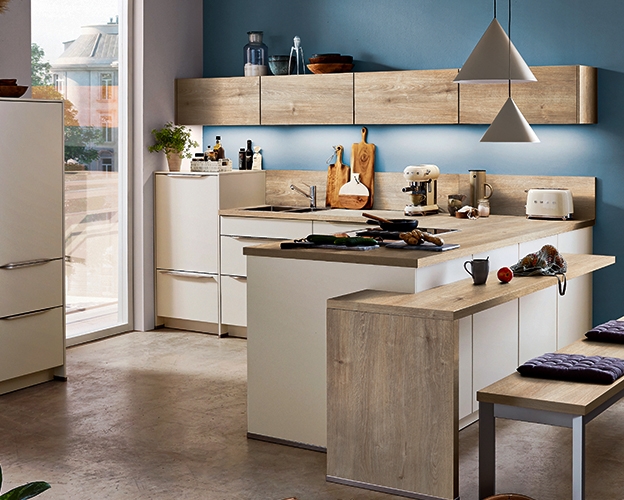What Are the Key Differences Between L-Shaped and U-Shaped Modular Kitchens?

When designing a kitchen, the layout plays a pivotal role in functionality, aesthetics, and efficiency. Two of the most popular designs are L-shaped and U-shaped modular kitchens. Each offers unique advantages and considerations, making them suitable for different spaces and lifestyles.
1. Layout and Structure
L-Shaped Modular Kitchens
The L-shaped modular kitchen features two adjacent walls that form a right angle, creating an efficient workspace. This layout is particularly beneficial for open-concept homes, as it allows for a seamless flow between the kitchen and adjoining living spaces. The L-shape maximizes corner space, providing ample room for appliances and storage while promoting easy movement around the kitchen.
U-Shaped Modular Kitchens
In contrast, the U-shaped modular kitchen consists of three walls, forming a ‘U’ shape. This layout offers more counter space and storage options than the L-shaped design, making it ideal for larger kitchens. The U-shape provides a distinct separation from other living areas, which can be beneficial for those who prefer a more enclosed cooking environment.
2. Space Utilization
Efficient Use of Space
Both layouts are designed to utilize space effectively, but they cater to different kitchen sizes. L-shaped kitchens are often ideal for smaller to medium-sized spaces, offering a compact yet functional design. This layout enables the cook to access everything within a short distance, promoting efficiency while preparing meals.
On the other hand, U-shaped kitchens shine in larger areas, where the three walls can be fully utilized for storage, appliances, and prep space. The extra counter space can accommodate multiple cooks or additional tasks, making it a fantastic choice for families or those who enjoy entertaining.
3. Storage and Counter Space
L-Shaped Kitchen Storage
L-shaped kitchens provide ample cabinet space, particularly in the corners, where special cabinets can maximize storage. The open area can be complemented with an island, which can serve as additional storage and a prep area. However, some homeowners may find that the L-shape offers slightly less countertop space compared to the U-shape.
U-Shaped Kitchen Storage
The U-shaped design excels in providing extensive storage options. With three walls of cabinets and countertops, this layout can house a larger number of cabinets, drawers, and pantry spaces. The configuration allows for more dedicated areas for appliances, utensils, and cookware, making organization easier and more efficient.
4. Workflow and Efficiency
Work Triangle Concept
Both kitchen designs can incorporate the work triangle concept, which emphasizes the efficiency of moving between the stove, sink, and refrigerator. In an L-shaped kitchen, the layout often naturally lends itself to this workflow, allowing for smooth transitions during meal preparation.
In a U-shaped kitchen, the triangular flow can be equally effective, but it may require more planning to ensure the workflow is optimized. The enclosed design may create more of a designated workspace, which can be beneficial for those who prioritize organization and structure.
5. Aesthetic Considerations
Style and Design Options
Both L-shaped and U-shaped kitchens can be designed to match a variety of aesthetics, from modern and sleek to rustic and cozy. The L-shaped kitchen’s open layout can lend itself to a more contemporary feel, often featuring islands or bar seating that promote social interaction.
U-shaped kitchens can be designed to create a more traditional or classic ambiance, with cabinetry that wraps around the room. The three walls can create a sense of enclosure that many find comforting and homey.
6. Flexibility and Customization
Personalization
Both kitchen layouts offer opportunities for personalization and customization. An L-shaped kitchen may allow for more creative freedom with open shelving or integrated dining areas, while a U-shaped kitchen can be customized with specialized storage solutions or innovative appliance placements.
Ultimately, the choice between these two designs should be based on your specific needs, preferences, and the overall layout of your home. By understanding these key differences, you can make an informed decision that enhances both the functionality and beauty of your kitchen.
Whether you opt for the sleek simplicity of an L-shaped kitchen or the expansive versatility of a U-shaped kitchen, both can create a warm and inviting environment for cooking and gathering.
- Industry
- Art
- Causes
- Crafts
- Dance
- Drinks
- Film
- Fitness
- Food
- الألعاب
- Gardening
- Health
- الرئيسية
- Literature
- Music
- Networking
- أخرى
- Party
- Religion
- Shopping
- Sports
- Theater
- Wellness
- News


